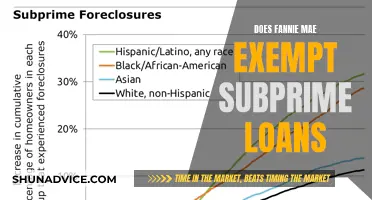
Many mortgage loans are sold and it's not always easy to tell who owns yours. If you're facing financial uncertainty, it's important to know who owns your loan as it could impact your options for mortgage relief solutions. For example, if your mortgage is owned or backed by Fannie Mae or Freddie Mac, you may be eligible for certain benefits or programs, such as loan modifications or refinancing options. Both entities were created by Congress to provide liquidity to the U.S. mortgage market. You can use the Freddie Mac and Fannie Mae Loan Lookup Tools to find out if either entity owns your loan.
| Characteristics | Values |
|---|---|
| How to find out if Fannie Mae or Freddie Mac owns your loan | Use the Fannie Mae or Freddie Mac loan lookup tools |
| What to do if facing financial uncertainty and having a Fannie Mae-owned loan | You may qualify for mortgage relief solutions like a forbearance plan, loan modification, or RefiNow™ |
| What to do if Freddie Mac does not own your loan | Check if Fannie Mae owns it |
| Requirements for lenders to help low-income homeowners | The refinance must result in a savings of at least $50 per month on the borrower’s mortgage payment and a reduction of at least 0.50% in the borrower’s interest rate |
| Benefits of owning a loan by Fannie Mae or Freddie Mac | Eligible for certain benefits or programs, such as loan modifications or refinancing options |
| Who owns the mortgage | The servicer you pay every month may not be the owner of the mortgage |
| How to find out who owns your mortgage | Contact your loan servicer online, by phone, or by written request |
What You'll Learn

Fannie Mae and Freddie Mac loan lookup tools
If you want to find out whether your mortgage is owned or guaranteed by Freddie Mac or Fannie Mae, you can use their online loan lookup tools. These tools are important for verifying mortgage holders, ensuring accurate payoffs, and clearing title liens. They can also help you understand what options are available for getting help with your mortgage.
To use the Fannie Mae Loan Lookup tool, go to the Fannie Mae website and fill in the required information, including your first and last name, address, and the last four digits of your Social Security Number. If you have a Fannie Mae-owned loan, you may qualify for mortgage relief solutions like a forbearance plan or loan modification. You might also be eligible for the RefiNow™ program, which can lower your interest rate and reduce monthly payments.
If Freddie Mac does not own your loan, no match will be returned. You can then check to see if Fannie Mae owns your loan using their online tool or by calling them toll-free. If Fannie Mae does own your loan, the resulting page will show a match. It is important to fill out the form carefully, as a mistake or typo can lead to inaccurate results.
Additionally, if your property is listed in either the Freddie Mac or Fannie Mae database, you can contact a team of loan experts to learn more about the loan options available to you.
Factoring: Understanding Loan Factor and Its Impact
You may want to see also

Benefits of Fannie Mae or Freddie Mac-owned mortgages
Fannie Mae and Freddie Mac are home mortgage companies created by the U.S. Congress and overseen by the Federal Housing Finance Agency (FHFA). They are both federally backed and provide liquidity, stability, and affordability to the mortgage market by offering readily available access to capital and guarantees to many banks, mortgage companies, and other financial institutions.
Fannie Mae, or the Federal National Mortgage Association (FNMA), was created in 1938 or 1939 to combat the lack of affordable housing during the Great Depression. It introduced a new type of mortgage to the market: the long-term, fixed-rate loan with an option to refinance at any time.
Freddie Mac, or the Federal Home Loan Mortgage Corporation (FMCC), was created in 1970 under the Emergency Home Finance Act to expand the secondary mortgage market and reduce interest rate risk for banks.
Fannie Mae and Freddie Mac buy mortgages from lenders and either hold them in their portfolios or package the loans into mortgage-backed securities (MBS) that may be sold. Lenders use the cash raised by selling mortgages to engage in further lending. Their purchases help ensure that individuals and families who buy homes and investors who purchase apartment buildings and other multifamily dwellings have a continuous, stable supply of mortgage money.
Fannie Mae and Freddie Mac also help stabilize the mortgage market and protect housing during extraordinary periods of turmoil in the broader financial system that threaten the economy. Their support for mortgage lending that finances affordable housing reduces the cost of borrowing.
FAFSA Loan Awards: What You Need to Know
You may want to see also

How to find out who owns your mortgage
It's not always easy to tell who owns your mortgage, as many mortgage loans are sold and the servicer you pay every month may not own your mortgage. Here are some ways to find out who owns your mortgage:
Check your monthly mortgage billing statement
Your servicer is the company that sends you the bill for payment. Look at your payment coupon book if you have one—the servicer will be listed there.
Contact your loan servicer
You can contact your loan servicer online, by phone, or by written request. The servicer is obligated to tell you who owns your mortgage loan. You can send a Qualified Written Request or a Request for Information.
Check the Freddie Mac and Fannie Mae Loan Lookup Tools
Many mortgages are owned by Fannie Mae and Freddie Mac. Both offer a mortgage lookup tool on their website.
Check the Mortgage Electronic Registration Systems (MERS) website
You can look up your mortgage servicer by searching the MERS website. If you have a MERS loan, call the MERS Servicer Identification System toll-free at 888-679-6377.
Review your loan paperwork
You might be able to find out who backs your mortgage loan by reviewing your loan paperwork. For example, if you have an FHA-insured loan, look for an FHA case number on your mortgage contract. If you're paying MIP (mortgage insurance premium), then you have an FHA-insured loan.
Extended Warranty Coverage: Loaner Vehicles Included?
You may want to see also

Fannie Mae and Freddie Mac business models
Fannie Mae and Freddie Mac are two of the most prominent enterprises in the US mortgage market. They are both government-sponsored enterprises (GSEs) that buy residential mortgages in the secondary market. They hold these mortgages or, more frequently, bundle and sell them as mortgage-backed securities (MBS) to investors. This process replenishes lenders with cash to issue further mortgages, injecting liquidity, stability, and affordability into the housing market.
Fannie Mae was founded in 1938 as a government agency and became a private entity in 1968. Freddie Mac, on the other hand, was established as a private company by an act of Congress in 1970 to provide competition to Fannie Mae. Both enterprises have experienced significant fluctuations in their stock values over the years, including a dramatic plunge when they entered government conservatorship during the 2008 financial crisis.
Freddie Mac has a diverse range of partnerships, including collaborations with lending institutions, technology providers, community organizations, and government entities. The company's key resources include its financial reserves, access to capital markets, lender relationships, IT infrastructure, and its relationship with the US government.
Fannie Mae and Freddie Mac have been under government conservatorship since 2008, but there have been discussions and expectations about their potential exit from government control. The fate of these enterprises may not become a priority for the administration until 2026, with some analysts predicting that the Treasury Department and FHFA will agree to release the companies after they retain their earnings for another year or two. However, it is important to note that any option that does not include a government backstop could potentially disrupt the markets due to the risk of defaults.
How EFC Affects Unsubsidized Stafford Loan Eligibility
You may want to see also

Fannie Mae and Freddie Mac loan limits
Fannie Mae and Freddie Mac have what is known as conforming loan limits (CLL) in place, which is the maximum amount they will purchase or guarantee on a loan. These limits are set by the Federal Housing Finance Agency (FHFA) and vary by location and are adjusted annually to reflect changes in home prices.
The conforming loan limit is the threshold that distinguishes conventional loans from "jumbo loans". Loans above the conforming loan limit are considered jumbo loans and are non-conforming, meaning they are not eligible for lenders to sell to Fannie Mae or Freddie Mac.
The conforming loan limit for 2025 has been set at $806,500 in most parts of the United States, an increase of 5.2% from the previous year. The limit can be higher in high-cost areas, which are determined by the FHFA and include places like California, Colorado, and Connecticut.
Lenders can use the Loan Limit Look-Up Table or FHFA's webpage to find the applicable loan limit for a specific county or metropolitan statistical area (MSA). Additionally, Fannie Mae and Freddie Mac provide a loan limit lookup tool on their official websites to help borrowers determine the conventional loan limit in their area.
Loans and Financial Intermediaries: An Inevitable Partnership?
You may want to see also
Frequently asked questions
You can use the Freddie Mac & Fannie Mae Loan Lookup Tools to find out if either entity owns your loan.
If your mortgage is owned or backed by either entity, you may be eligible for certain benefits or programs, such as loan modifications or refinancing options.
If you are having difficulty paying your mortgage on time, your lender (also referred to as a mortgage servicer) should be your first call for assistance. Their contact information should be listed on your monthly statement.
You can find the number for your mortgage servicer on your monthly mortgage statement or coupon book. You can also look up your mortgage servicer by searching the Mortgage Electronic Registration Systems (MERS) website.
You may qualify for helpful mortgage relief solutions such as a forbearance plan or loan modification. You might also be eligible for RefiNow™—an option that can lower your interest rate and reduce monthly payments.







